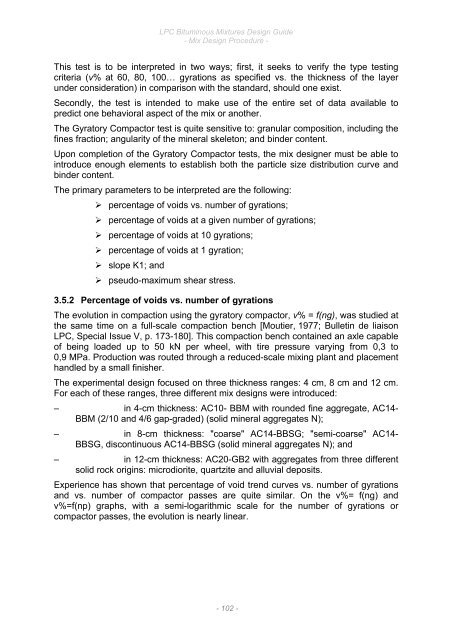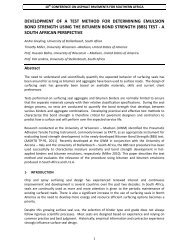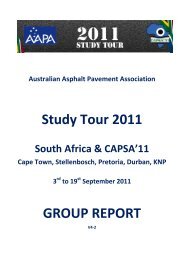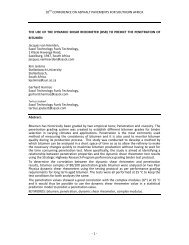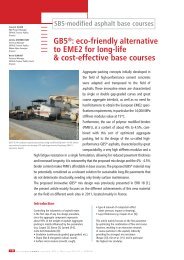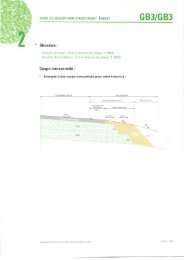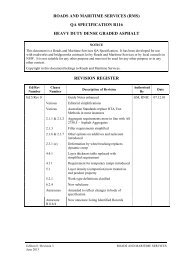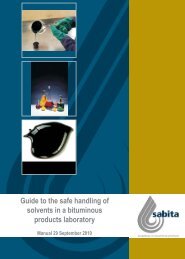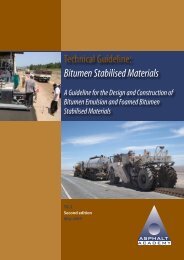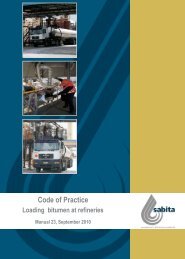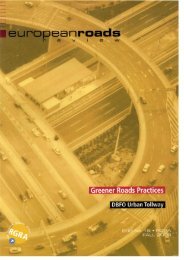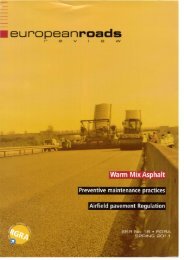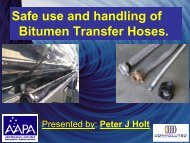<strong>LPC</strong> <strong>Bituminous</strong> <strong>Mixtures</strong> <strong>Design</strong> <strong>Guide</strong>- Mix <strong>Design</strong> Procedure -This test is to be interpreted in two ways; first, it seeks to verify the type testingcriteria (v% at 60, 80, 100… gyrations as specified vs. the thickness of the layerunder consideration) in comparison with the standard, should one exist.Secondly, the test is intended to make use of the entire set of data available topredict one behavioral aspect of the mix or another.The Gyratory Compactor test is quite sensitive to: granular composition, including thefines fraction; angularity of the mineral skeleton; and binder content.Upon completion of the Gyratory Compactor tests, the mix designer must be able tointroduce enough elements to establish both the particle size distribution curve andbinder content.The primary parameters to be interpreted are the following:‣ percentage of voids vs. number of gyrations;‣ percentage of voids at a given number of gyrations;‣ percentage of voids at 10 gyrations;‣ percentage of voids at 1 gyration;‣ slope K1; and‣ pseudo-maximum shear stress.3.5.2 Percentage of voids vs. number of gyrationsThe evolution in compaction using the gyratory compactor, v% = f(ng), was studied atthe same time on a full-scale compaction bench [Moutier, 1977; Bulletin de liaison<strong>LPC</strong>, Special Issue V, p. 173-180]. This compaction bench contained an axle capableof being loaded up to 50 kN per wheel, with tire pressure varying from 0,3 to0,9 MPa. Production was routed through a reduced-scale mixing plant and placementhandled by a small finisher.The experimental design focused on three thickness ranges: 4 cm, 8 cm and 12 cm.For each of these ranges, three different mix designs were introduced:– in 4-cm thickness: AC10- BBM with rounded fine aggregate, AC14-BBM (2/10 and 4/6 gap-graded) (solid mineral aggregates N);– in 8-cm thickness: "coarse" AC14-BBSG; "semi-coarse" AC14-BBSG, discontinuous AC14-BBSG (solid mineral aggregates N); and– in 12-cm thickness: AC20-GB2 with aggregates from three differentsolid rock origins: microdiorite, quartzite and alluvial deposits.Experience has shown that percentage of void trend curves vs. number of gyrationsand vs. number of compactor passes are quite similar. On the v%= f(ng) andv%=f(np) graphs, with a semi-logarithmic scale for the number of gyrations orcompactor passes, the evolution is nearly linear.- 102 -
<strong>LPC</strong> <strong>Bituminous</strong> <strong>Mixtures</strong> <strong>Design</strong> <strong>Guide</strong>- Mix <strong>Design</strong> Procedure -A sigmoid model (S-shaped) was applied to the v%=f(ng) curve in order to deduce extreme clampingbehavior at a very high number of gyrations (curve asymptote). This model is relevant for the range ofmaterials tested (AC-BBSG, HRA, AC-BBM). The compacity of the granular skeleton submitted tohigh energy levels tends to a limit, denoted C∞; this compacity value is greater than those obtained attypical gyration thresholds (< 200) and suggests that even for very angular mixes, an additional"clamping potential" remains over and above current specifications. Such potential can be realizedduring exceptional climatic or traffic conditions.Modeling of Gyratory Compactor results - Assessment of ultimate compaction threshold,F. Moutier, Eurasphalt & Eurobitume Conference '963.5.3 Percentage of voids at a given number of gyrationsComparing the percentage of voids measured on specimens generated from thestudied plates for a "standard" compaction mode (approximately 16 passes) with thatderived using the gyratory compactor by direct geometric measurement hasdemonstrated that: for mixes applied in 4-cm thickness, the correspondingpercentage of voids was obtained at 40 gyrations; and for 8-cm thick mixes, 80gyrations were required to reach this void level. Experimentation conducted on 12-cmthick material samples proved less conclusive. The 40-gyration relationship for the 4-cm material (AC-BBM and PA-BBDr ranges) and evaluation at 80 gyrations formaterials spread over 8 cm (AC14-BBSG or AC14-BBME) initiated adoption of theFrench specifications. Following a few extra experimental findings, this relation wasgeneralized: 25 gyrations for 2,5-cm thick BBTM; 60 gyrations for AC10-BBSG orAC10-BBME spread 6 cm thick; 100 gyrations for AC14-GB or AC14-EME ( highmodulus mixes) applied approximately 10 cm thick; 120 gyrations for AC20-GB orAC20-EME applied approximately 12 cm thick. These percentage of void ranges,associated with gyration number vs. layer thickness, have become laboratoryspecifications, aimed at predicting the percentage of voids attained on the jobsite.The predictive capacity of the percentage of voids parameter at n gyrations had beenanalyzed as part of a survey entitled: "Gyratory compactor testing assessment" withinthe <strong>LPC</strong> research network [Ballie, Delorme, Hiernaux and Moutier, Bulletin de liaison<strong>LPC</strong>, Issue no. 170]; this work showed that the value identified in the laboratorytended to be somewhat pessimistic for the Grave-Bitume AC-GB and AC14-BBSG,evenly valued for AC10-BBSG and more optimistic for thinner mixes. These relationsdepend on trends tied to: material mix design (e.g. cessation of the use of roundedmaterials), mix production mode (drum mixers), and type of spreading andcompaction (vibratory compactors). Such factors need to be incorporated wheneverthe value targeted for a jobsite is deduced on the basis of a laboratory-determinedpercentage of voids.A study on crushed bituminous aggregate, high modulus mixtures and semi-coarsebituminous concretes has been carried out (see Section 4.1) in order to verify thecorrespondence between the percentage of voids measured: on laboratory materials(representative of worksite conditions), on materials extracted from onsite mixingplants using a mobile gyratory compactor, and onsite by means of gammadensitometers.With the exception of one site where production uncertainties led tounder-compaction, the average results obtained at each stage were for the most partsimilar (maximum deviation: 1,4%).- 103 -


